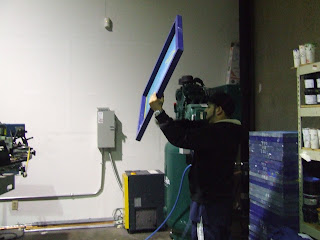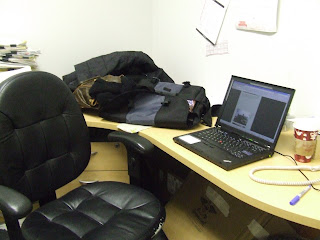counter
Wednesday, December 23, 2009
Tuesday, December 22, 2009
Monday, December 21, 2009
Tuesday, December 15, 2009
Packing and Shipping PLUS PMS match
 Almost 5 years in this company and I always thought that when we ordered a PMS match, there is a warehouse full of paint bottles with a specific pantone color. Am I an idiot or what?
Almost 5 years in this company and I always thought that when we ordered a PMS match, there is a warehouse full of paint bottles with a specific pantone color. Am I an idiot or what?Cesar has to mix those colors to get the right PMS. 15% of this 15% of that add black, add white and voila PMS whatever. The pantone book is like a guide which tells what percentage of the basic colors make up a pms.
So those of us who are outraged by the CIF's on pantone color.... Oh well, live and learn.
I had to make a google search about mixing pantone colors and found an answer from one of the forums.
An answer to the question about how paint is mixed... and the answer is
It's all surprisingly low tech! They mix inks from various tins.
Picking a colour completely at random from a colour book,
brown 4705
is4 parts or 18.2% Yellow
4 parts or 18.2% Ruby red
3 parts or 13.6% Black
11 parts or 50% Translucent white
A machine for mixing Pantone is available for about $3000
 The reason 12 pieces cost more than 48 or 72 or 144. Can you imagine mixing a small batch of ink for 12 pieces? And the customer complaining it doesn't look right....
The reason 12 pieces cost more than 48 or 72 or 144. Can you imagine mixing a small batch of ink for 12 pieces? And the customer complaining it doesn't look right....


 They were working on embroidered jackets for Tom Griffin's order when I got there.
They were working on embroidered jackets for Tom Griffin's order when I got there.They packed them in poly bags then into the boxes. Only 20 jackets to a box. Freight depends not only on weight but also on the size of the box.

The UPS guy. Sometimes Joel has to chase him around town when the boxes are not ready to be picked up. Dennis, the UPS guy, is a huge help. If it is too late to chase after Dennis and some order needs to ship , Joel drives to the Oakland UPS office to make sure the delivery goes out that day. Oakland is about an hour away.
Screen Printing
 All done ready to be packed and shipped.
All done ready to be packed and shipped.


This is where they"cure" the printed items. This will make sure the ink stays on the fabric.



I asked how they ensure the shirt or bag does not move in the process which can produce uneven /overlapping printing. The answer is ADHESIVE. They spray adhesive on the board to hold the fabric in place.
Evolution Screen printing (preparation)
 These are stacks of used screens which they will reclaim by cleaning with some solvent.
These are stacks of used screens which they will reclaim by cleaning with some solvent.
 I know I shot a picture where they use a machine to blow dry it. But I can't find the picture.
I know I shot a picture where they use a machine to blow dry it. But I can't find the picture.

 Then it has to be wiped dry. It needs to be absolutely dry.
Then it has to be wiped dry. It needs to be absolutely dry. Cleaning the screen with something that works like a water hose.
Cleaning the screen with something that works like a water hose.




 They wash the screen to reveal the design.
They wash the screen to reveal the design. They showed me how this one was 'burned' on the screen. The screens have different thicknesses or gauge. It will depend on the art that is needed. A 4cp will need a mesh with very thin holes. The ink must also be thinner so it can pass through those tiny holes.
They showed me how this one was 'burned' on the screen. The screens have different thicknesses or gauge. It will depend on the art that is needed. A 4cp will need a mesh with very thin holes. The ink must also be thinner so it can pass through those tiny holes. These are some of the screens they have used. Cesar has a small table with lines that show him whether the mesh is set up correctly . He then tapes the film onto the mesh. If it is a 2 color logo, he first sets the smaller film on top of the bigger film to make sure it is set up correctly. He then tapes the smaller art on the first set up. He proceeds with taping the second set up. I didn't take a picture because it was dark in the room while he was working and didn't want to bother him with the flash of the camera. It is a super tedious process that is only made easy by years of practice.
These are some of the screens they have used. Cesar has a small table with lines that show him whether the mesh is set up correctly . He then tapes the film onto the mesh. If it is a 2 color logo, he first sets the smaller film on top of the bigger film to make sure it is set up correctly. He then tapes the smaller art on the first set up. He proceeds with taping the second set up. I didn't take a picture because it was dark in the room while he was working and didn't want to bother him with the flash of the camera. It is a super tedious process that is only made easy by years of practice. This is where they burn the image on mesh screen. The process allows the transfer of the art onto the mesh.
This is where they burn the image on mesh screen. The process allows the transfer of the art onto the mesh.
Subscribe to:
Comments (Atom)
























